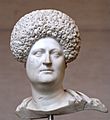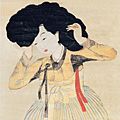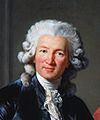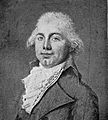Wig facts for kids
A wig is a covering made of hair that people wear on their heads. It can be made from real human hair, animal hair, or even fake hair fibers. The word "wig" is actually a shorter version of an older word, "periwig," which started being used around 1675.
People wear wigs for many different reasons. Sometimes, they wear them to cover up if they have very little or no hair on their head, which is called being bald. Actors often use wigs to change how they look for a role, helping them become a character in a play or movie. In countries like Britain and other Commonwealth countries, some public workers, such as judges and lawyers, wear special wigs as part of their official uniform.
Wigs Through History
Wigs have been popular for a long time! Many famous composers in the 1700s, like Wolfgang Amadeus Mozart and Johann Sebastian Bach, wore wigs. These wigs were often big and fancy, showing off a person's importance.
-
Wolfgang Amadeus Mozart wearing a wig.
-
Johann Sebastian Bach wearing a wig.
-
George Frideric Handel wearing a wig.
-
A portrait by Nicolas de Largillière, a French painter. He painted a man with a wig.
Wigs were also common in ancient times. People in ancient Egypt wore wigs to protect their heads from the sun and for special ceremonies. In ancient Rome, women often wore wigs or added hairpieces to their own hair to create elaborate hairstyles.
During the 16th century, Queen Elizabeth I of England was known for wearing many different red wigs. Later, in the 17th and 18th centuries, wigs became very fashionable in Europe, especially for men. They were often powdered white or in other colors.
Wigs Today
Today, wigs are still used for many reasons. People wear them for fashion, to change their look, or for fun at costume parties. They are also important for people who have lost their hair due to medical reasons. Wigs come in many different styles, colors, and lengths, from very natural-looking ones to bright and colorful designs.
Images for kids
-
People showing how wigs were made long ago in Colonial Williamsburg, Virginia.
-
A Wig Headdress made by the Wari People between 600 and 1000 CE.
-
Queen Elizabeth I in 1588.
-
Marie Antoinette wearing a tall "pouf" wig style.
-
Charles-Alexandre de Calonne painted by Élisabeth-Louise Vigée-Le Brun (1784).
-
John Adams in 1788.
-
Thomas Jefferson in 1786.
-
James Madison around 1770-1780.
-
James Monroe in 1794.
See also
 In Spanish: Peluca para niños
In Spanish: Peluca para niños




























